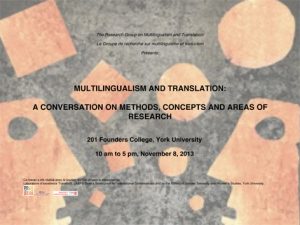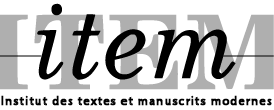
Workshop Program
10:00 – 10:10 am
Eva Karpinski
Welcome Remarks and Introduction to the Workshop
Morning Chair : Susan Ingram
10:15 – 11:15 — Presentations + Q & A
Elena Basile, “Ecologies of Citizenship in Translation: Multilingualism in Experimental Poetics”
Maria Constanza Guzmàn, « Spaces of Translation in the Americas: Languaging from the Borders »
Short Break
11:20 –12:20 – Presentations + Q & A
Chiara Montini, “What is a multilingual text? From practice to theory”
Antonietta Sanna, « La voix de la langue en sourdine. Ce que montrent les manuscrits des auteurs multilingues »
12:30 pm – 2 pm LUNCH BREAK
Afternoon Chairs: Elena Basile and Kerry Doyle
2:15 – 3:15 pm — Presentations and Q & A
Rainier Grutman, « Heterolingualism: why, whence, and whither? »
Eva Karpinski, « Multilingualism from above and from below: Politicizing the concept in the age of globalization »
Short Break
3:20 – 4:20 – Presentations and Q & A
Dunja Baus and Paola Bohorquez, “breaking SWEat: the place of translation in critical approaches to teaching linguistically diverse
students”
Dominique Scheffeld-Dunand, “Portraits of Urban Linguistic Ecologies. Or the Mapping of Underrepresented Languages in Toronto”
4:30 pm – 5 pm Roundtable Discussion
“Between Translation and Multilingualism. What is the use
(usage and value) of definitional boundaries?”
—
ABSTRACTS
Dunja Baus and Paola Bohorquez, “breakingSWEat: the place of translation in critical approaches to teaching linguistically diverse students”
In this presentation, we will reflect on our own pedagogical experiences as writing teachers of linguistically diverse students. These experiences have prompted a pilot project that proposes to produce pedagogical methodologies that integrate translation strategies and metalinguistic skills to teach writing outside of the « deficit paradigm » inherited by TESL educators. While we’re aware that current institutional rhetoric acknowledges students’ diverse linguistic backgrounds and the legitimacy of « other englishes », it is our experience that very little of this rhetoric translates to practice in our culturally and linguistically diverse classrooms. In other words, there is a fundamental breakbetween progressive theories of pedagogy and what we’re doing in the classroom. We are particularly interested in thinking with and through the following questions: what does it mean to think about critical writing pedagogies through the lens of multilingualism? What are the effects of applying translative/translation strategies on the learning of SWE? How do such strategies impact students’ approaches to English and writing?
Elena Basile: « Ecologies of citizenship in translation: multilingualism in experimental poetics »
Drawing on Cronin’s idea of “micro-cosmopolitanism,” this presentation explores instances of contemporary poetic practices in Canada that grapple with questions of citizenship and belonging via a strategic textual staging of stratified (hegemonic and minor) configurations of linguistic diversity. I am particularly interested in looking at how poets such as Erin Moure, Nathanael, Rachel Zolf, Rita Wong and Gail Scott interrogate (and mobilize) the anchoring of bodies/ (and)/lands into hierarchies of symbolically legitimated existence via rendering visible zones of underworld “translatio” (Apter) in their writing. I want to further interrogate the fuzzy boundaries between multilingualism and translation in these texts in light of some of the problems they raise with regards to their reception and circulation among different (counter)publics.
Rainier Grutman: « Heterolingualism: why, whence, and whither? »
In this presentation, I will try to show the relevance of the term « heterolingualism » for the study of multilingual writing. After explaining why this term was coined in the early 1990s in (French) Canada, I will map out some of its conceptual connections with and oppositions to pre-existing terminology (most notably, Bakhtin’s heteroglossia, but also diglossia, bilingualism, code-switching and mixing) and reflect on some new avenues of research it can open up (and in many cases, has already opened up).
Maria Constanza Guzmàn « Spaces of Translation in the Americas: Languaging from the Borders »
This paper is premised on the possibility of thinking of “spaces of translation” specific to the Americas. I look at the notion of space in the Americas as conditioned and produced by coloniality and its legacies, and focus on the border-zone, in its geo-historical specificity, as a space of contact, a contact zone where the multi-layered transculturations of the continent are manifest, and where languages and subjectivities are produced. After the conceptualization of the “space of translation” of the Americas, for which I draw on literary and cultural studies and on theoretical proposals by both North American (e.g., Emily Apter, Mary Louise Pratt) and Latin American (Ángel Rama, Silviano Santiago) scholars, and specifically on writings by the Latin American decolonial group (e.g, Aníbal Quijano, Walter Mignolo), I discuss the reverberations of this notion on theories of language and translation. I finish by looking at contemporary “Portunhol” (or, rather, los portuñoles), a mixture of Spanish and Portuguese which has emerged in Latin America in different ways and forms, and in diverse areas of contact and crossing (from the Amazon to Uruguay), and which, in its contemporary forms, offers a case to observe language hybridity and acts of “languaging” through various genres and media (e.g., poetry and music, blogs). I view these portuñolesas a site where relations across languages and communities are negotiated and as a symptom of the Americas’ historical present.
Eva Karpinski: « Multilingualism from above and from below: Politicizing the concept in the age of globalization »
I want to reflect on different valences of multilingualism in the geopolitical space fractured by uneven vectors of globalization and its colonial legacies. Following Alison Phipps, I distinguish between multilingualism “from above,” linked to economic privilege, free mobility, and commodity exchange, and multilingualism “from below,” associated with pre-modern temporality, non-marketability, and invisibility. While the former comprises dominant majority languages with global currency, spoken by transnational elites (financial, business, and academic), the latter refers to those rare, local, “minor” languages that belong to indigenous peoples, subalterns, asylum seekers, refugees, and migrant workers. Considering the viability of coalitionist efforts (environmentalist and linguistic) to protect biodiversity and linguadiversity, I revisit the issue of linguistic human rights through Gayatri Spivak’s “Translation as Culture.”
Chiara Montini “What is a multilingual text? From practice to theory”
Generally speaking, we refer to multilingualism when the author is multilingual. But what is a multilingual text? Can we say that a text containing some foreign words is multilingual? Eva Hoffman’s Lost in translation contains some words in Polish, but it is written in English and her fictional writings are mainly “monolingual”. On the other hand, if we read a text by Samuel Beckett, let’s say, in French, we may not be able to say that it is multilingual. But if we analyse its language together with the twin text in English (as he systematically translated his texts from one language to the other), we would recognise his poetics as bilingual and his texts as multilingual. James Joyce is unequivocally multilingual, but he writes “only” in English. Drawing from these general considerations, I would like to tackle the status of multilingual texts proposing some strands of inquiry that may help to define a poetics of multilingualism.
Antonietta Sanna, « La voix de la langue en sourdine. Ce que montrent les manuscrits des auteurs multilingues »
Nombreux sont les écrivains qui suivant les intempéries du XX et XXème siècles ont quitté leur pays et leur langue pour se réfugier dans un autre pays et dans une autre langue. Ces écrivains ont passé des frontières, expérimenté l’exil et le déracinement avant de trouver dans une autre langue l’accueil nécessaire à l’écriture. Ils se sont retrouvés dans l’épaisseur d’une langue possédée oralement et dans la densité d’une langue autre possédée à l’écrit. Dans l’entrelacement des langues, dans cet espace de l’entre-deux-langues, quel rôle jouent les deux codes linguistiques, celui de la langue d’accueil et celui de la langue des affects, au niveau de l’écriture? L’approche génétique peut rendre compte des dynamiques entre les codes. A travers l’analyse des documents qui illustrent le processus créateur elle peut montrer, parfois même contre les déclarations des écrivains, la présence dans la langue d’accueil des apports d’une langue des affects que l’on peut définir nourrice.
Dominique Scheffeld-Dunand, « Portraits of Urban Linguistic Ecologies. Or the Mapping of Underrepresented Languages in Toronto »
There is no doubt that Toronto is a city abundant with different languages and cultures. In a city with so many diverse speakers it is important that differences are acknowledged and embraced. As Urban Linguistic Ecologists our main goal is to uncover the languages of current new immigrants (in the GTA) in aims of preventing these languages from being underrepresented in different spheres of Canadian life, such as health care. This project looks at theoretical frameworks, conceptual tools and methods to:
a. document underrepresented languages of new immigrants coming to Canada using a breadth of data collecting methods (surveys, interviews, mapping…)
b. collect data about these languages in aims of raising awareness about the need for services and programs tailored to underrepresented speakers in the GTA
c. give a voice to groups who speak underrepresented languages
d. support initiatives of service providers in order to align their services with the needs of underrepresented groups.
e. redefine linguistic diversity in a Canadian context
f. train students in order to equip them with the skills necessary for assisting with the initiatives of linguistic diversity.

















